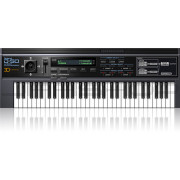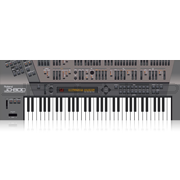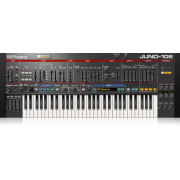You're currently on:

TR-707 / TR-727 Software Rhythm Composers
Dynamic digital duo
In 1985 Roland released the now-famous TR-707 and TR-727 Rhythm Composers. Taking their rightful places next to other classic Roland rhythm machines, this dynamic duo of drums and percussion has appeared on hit tracks in a long list of genres, including synth pop, acid house, industrial, electro, indie, alternative, and more. Thanks to our Analog Circuit Behavior (ACB) technology, you can now have the authentic sound and experience of these influential drum machines right inside your DAW—with modern upgrades that take them into all-new territory.
Features
- Analog Circuit Behavior technology captures every detail of the original hardware
- Uses the original TR-707 and TR-727 sample ROMs
- Includes all sounds and patterns from the original units
- New patterns and kits for modern style
- Get modern sounds with tuning, decay, gain, sample rate adjustment, and more
- Powerful sequencer with flams, sub-steps, last step, and per-instrument shuffle
- Drag and drop audio or MIDI patterns directly to DAW tracks or cells
- Original and aged skins along with LCD-style sequencer windows
- Multiple outputs for flexible effects processing with plugins like ZENOLOGY FX
- VST3, AU, and AAX support for popular DAWs
- Native support for Apple silicon

Digital transition.
Before the TR-707 and TR-727, Roland released the now-legendary TR-909, which was developed as an analog-digital hybrid rather than a fully digital device. Memory chips and digital-to-analog converters were costly at the time, so there was concern that an all-digital design would make the product unaffordable for many musicians and would have limited sound shaping options. However, after the TR-909’s release, Roland embraced the trend towards digital technology with a pair of rhythm machines that combined sampled sounds with the user-friendly TR interface—newly enhanced with the hands-on immediacy of individual faders.

Orange, blue, or both?
The new digital TR machines were highly anticipated when they hit the market. The TR-707, with its orange livery, had the most advanced pattern sequencing capabilities yet and included 15 punchy drum sounds covering all the basics, from kick and snare to toms and cymbals. Its sibling, the blue-highlighted TR-727, was an all-out percussion powerhouse with 15 Latin-inspired sounds that could take any groove to new heights. Each unit was formidable on its own, but together they were unstoppable.

The sound of vintage digital.
Developed in the mid-1980s, the TR-707 and TR-727 had a 25 kHz, 8-bit (or 6-bit for some tones) sample playback engine that was primitive by today’s standards. These low bit rates caused quantization noise during the sound’s decay, so non-decaying PCM waveforms were used, with decay introduced later in the analog circuitry. Furthermore, deviations in the clock and the analog circuitry downstream of the D/A converter caused variances in the pitch and decay characteristics. And though the TR-707 and TR-727 lacked the ability to edit sounds, the combination of these factors ultimately led to them being highly sought after for their unique and pleasing lo-fi punch.
100% authentic sound and behavior.
Even though the TR-707 and TR-727 were primarily digital devices, it’s impossible to perfectly capture their unique sound using samples. To replicate these sounds in software, we started with the original PCM wave data found on the classic machines, then used our Analog Circuit Behavior modeling to completely recreate the PCM output stage, carefully including all of its quirks and instabilities. Modeling the analog envelope and amplifier stages that came after the D/A converter allowed us to implement tuning, decay, PCM clock adjustment, and other parameters available in the plugin but not present on the original units.

The full experience. And more.

Great care has gone into making the TR-707 and TR-727 feel special to use, just like the original hardware. Realistic new and aged skins match your vibe, and both models include all the original sounds and patterns. But these recreations go way beyond vintage with patterns for modern genres, wicked sound-shaping options, powerful sequencing, drag and drop audio/MIDI to your DAW, multi-out, and more. The 707 and 727 even work together as a unit with matching kits and patterns that perfectly complement each other. Load a kit, load a pattern, and let the magic happen.

Sound that goes from vintage to radical.
Taking inspiration from after-market modifications, our advanced circuit modeling offers parameters that let you dig under the hood and modify the sound in all manner of ways. You can adjust the Attack of the Bass Drum and the Snappy of the Snare, and every sound has ultra-smooth tuning and decay. You can even overdrive the internal circuitry, tweak how each PCM waveform behaves, and adjust the PCM clock from 6.25 kHz to 100 kHz for some serious sonic mischief.

Ultra-powerful sequencing.
While the sequencer on the original TR-707 and TR-727 was the most advanced we’d ever made, the updated sequencer here goes much further, incorporating features that let you add detail and nuance to your grooves. Opening the sequencer’s expanded edit panel reveals individual sequencer lanes with mute, solo, and adjustable shuffle for each instrument. Per-step accent is included, and each step can trigger hard or weak hits, alternate sounds, three types of sub-steps, and nine types of flams.

From 1985 straight to your DAW.
The TR-707 and TR-727 Software Rhythm Composers bring the totally authentic experience of using these classic machines direct to your studio. And while they capture the vintage vibe of these instruments, they’re thoroughly modern in their support for today’s workflow. The detailed user interfaces are fully resizable for any display setup, and you can drag and drop MIDI and audio patterns directly to tracks or cells. Both plugins are VST3, AAX, and AU compatible and have native support for Apple silicon.

























































































